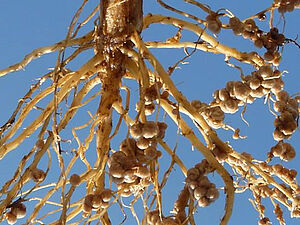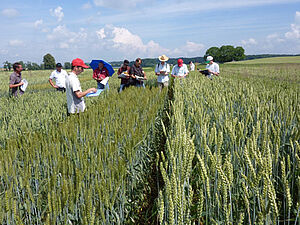

Plant breeding research contributes significantly to the ecological intensification of the organic farming system and its adaptation to climate change. Main breeding goals are, besides yield stability, water and nutrient use efficiency, tolerance against diseases and pests, and changing environmental conditions.
Besides main crops, which are intensively bred by commercial seed companies, breeding programs that focus on minor crops, in particular on legumes (biological nitrogen fixation) and regionally relevant crop species, are urgently needed. The long-term maintenance of agro-ecological biodiversity (diverse crop rotations), the reduction of risks for extreme weather conditions, and the development of niche markets are essentially dependent on such breeding programs.
The diversity of crop species and varieties is indispensable for the development of site-adapted crop rotations, the production of diverse food, and a continuous adaptation to a changing environment.
Research approaches
FiBL is particularly involved in the breeding projects of crop plants where the varieties do not meet the needs of the organic sector, where the supply of organically propagated seeds is too low or the number of varieties is too limited. We are increasingly seeking cooperation with organic farmers in order to jointly evaluate and develop varieties.
FiBL’s breeding projects deal with, for example, the following questions:
- What is the effect of the selection environment on the breeding gain for organic cultivation?
- Do interactions exist between varieties and cultivation methods (wheat, corn, cotton)?
- Is it possible to increase biological nitrogen fixation via a combined selection of soybean and symbiotic microorganisms?
- How can F1 hybrids be used for developing open pollinated varieties?
- How can participatory approaches be combined with new technologies for improving the cotton breeding progress and ensuring the availability of genetically free seeds for organic cultivation?
- What are the research needs for seed supply in developing countries?
- Under which criteria can breeding techniques be evaluated? Organic farming has special demands regarding their varieties and propagation materials. The increasing use of genetic engineering in conventional plant breeding research demands the strengthening of alternative research and breeding activities within the organic sector (FiBL Projects Plant Breeding Research Crop cultivation cultures & vegetables FiBL Switzerland).
- How can agrobiodiversity be used and marketed sustainably?
Agrobiodiversity: Diversity of crop species and varieties
Agrobiodiversity describes the part of biological diversity that plays a central role in agriculture and food production (definition by the Food and Agriculture Organization of the United Nations FAO and the Convention on Biological Diversity CBD). Agrobiodiversity results from the interaction of genetic resources, environmental factors and the people who have been working in agriculture and livestock farming. This diversity has been and continues to be the basis for diverse, locally adapted production systems that are indispensable for plant protection, the preservation of soil fertility and the world’s food supply. Agrobiodiversity will only be preserved if it continues to be used by farmers and can thus continuously adapt to changing environmental conditions.



